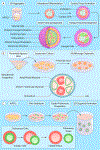Alliance of Heart and Endoderm: Multilineage Organoids to Model Co-development
- PMID: 36795851
- PMCID: PMC9942098
- DOI: 10.1161/CIRCRESAHA.122.321769
Alliance of Heart and Endoderm: Multilineage Organoids to Model Co-development
Abstract
Studies in animal models tracing organogenesis of the mesoderm-derived heart have emphasized the importance of signals coming from adjacent endodermal tissues in coordinating proper cardiac morphogenesis. Although in vitro models such as cardiac organoids have shown great potential to recapitulate the physiology of the human heart, they are unable to capture the complex crosstalk that takes place between the co-developing heart and endodermal organs, partly due to their distinct germ layer origins. In an effort to address this long-sought challenge, recent reports of multilineage organoids comprising both cardiac and endodermal derivatives have energized the efforts to understand how inter-organ, cross-lineage communications influence their respective morphogenesis. These co-differentiation systems have produced intriguing findings of shared signaling requirements for inducing cardiac specification together with primitive foregut, pulmonary, or intestinal lineages. Overall, these multilineage cardiac organoids offer an unprecedented window into human development that can reveal how the endoderm and heart cooperate to direct morphogenesis, patterning, and maturation. Further, through spatiotemporal reorganization, the co-emerged multilineage cells self-assemble into distinct compartments as seen in the cardiac-foregut, cardiac-intestine, and cardiopulmonary organoids and undergo cell migration and tissue reorganization to establish tissue boundaries. Looking into the future, these cardiac incorporated, multilineage organoids will inspire future strategies for improved cell sourcing for regenerative interventions and provide more effective models for disease investigation and drug testing. In this review, we will introduce the developmental context of coordinated heart and endoderm morphogenesis, discuss strategies for in vitro co-induction of cardiac and endodermal derivatives, and finally comment on the challenges and exciting new research directions enabled by this breakthrough.
Keywords: cardiac organoid; endoderm; foregut; intestine; lung.
Figures


Similar articles
-
Co-development of mesoderm and endoderm enables organotypic vascularization in lung and gut organoids.Cell. 2025 Aug 7;188(16):4295-4313.e27. doi: 10.1016/j.cell.2025.05.041. Epub 2025 Jun 30. Cell. 2025. PMID: 40592324
-
Recapitulating human cardio-pulmonary co-development using simultaneous multilineage differentiation of pluripotent stem cells.Elife. 2022 Jan 12;11:e67872. doi: 10.7554/eLife.67872. Elife. 2022. PMID: 35018887 Free PMC article.
-
Co-emergence of cardiac and gut tissues promotes cardiomyocyte maturation within human iPSC-derived organoids.Cell Stem Cell. 2021 Dec 2;28(12):2137-2152.e6. doi: 10.1016/j.stem.2021.11.007. Cell Stem Cell. 2021. PMID: 34861147
-
Self-organization of organoids from endoderm-derived cells.J Mol Med (Berl). 2021 Apr;99(4):449-462. doi: 10.1007/s00109-020-02010-w. Epub 2020 Nov 22. J Mol Med (Berl). 2021. PMID: 33221939 Free PMC article. Review.
-
Organogenesis in vitro.Curr Opin Cell Biol. 2021 Dec;73:84-91. doi: 10.1016/j.ceb.2021.06.007. Epub 2021 Aug 2. Curr Opin Cell Biol. 2021. PMID: 34352726 Free PMC article. Review.
Cited by
-
Advances in the Generation of Constructed Cardiac Tissue Derived from Induced Pluripotent Stem Cells for Disease Modeling and Therapeutic Discovery.Cells. 2024 Jan 29;13(3):250. doi: 10.3390/cells13030250. Cells. 2024. PMID: 38334642 Free PMC article. Review.
-
Advances in humanoid organoid-based research on inter-organ communications during cardiac organogenesis and cardiovascular diseases.J Transl Med. 2025 Mar 28;23(1):380. doi: 10.1186/s12967-025-06381-x. J Transl Med. 2025. PMID: 40156006 Free PMC article. Review.
-
Modeling heart rhythm using human engineered heart tissues.Nat Protoc. 2025 Aug 1. doi: 10.1038/s41596-025-01217-w. Online ahead of print. Nat Protoc. 2025. PMID: 40750715 Review.
-
Model construction and clinical therapeutic potential of engineered cardiac organoids for cardiovascular diseases.Biomater Transl. 2024 Nov 15;5(4):337-354. doi: 10.12336/biomatertransl.2024.04.002. eCollection 2024. Biomater Transl. 2024. PMID: 39872935 Free PMC article. Review.
-
Guided Differentiation of Pluripotent Stem Cells into Heterogeneously Differentiating Cultures of Cardiac Cells.bioRxiv [Preprint]. 2025 Feb 19:2023.07.21.550072. doi: 10.1101/2023.07.21.550072. bioRxiv. 2025. PMID: 37502898 Free PMC article. Preprint.
References
-
- Steimle JD, Rankin SA, Slagle CE, Bekeny J, Rydeen AB, Chan SS-K, Kweon J, Yang XH, Ikegami K, Nadadur RD, et al. Evolutionarily conserved Tbx5-Wnt2/2b pathway orchestrates cardiopulmonary development. Proceedings of the National Academy of Sciences. 2018;115:E10615–E10624. doi: 10.1073/pnas.1811624115 - DOI - PMC - PubMed
Publication types
MeSH terms
Grants and funding
LinkOut - more resources
Full Text Sources

